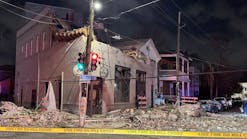SUBJECT: Lifting Heavy Loads, Part 7
TOPIC: NFPA 1670 Technician-level Joint Fire/Rescue and Tow Truck Training
OBJECTIVE: Rescue personnel shall become familiar with the application of commercial heavy wreckers and recovery services to assist at incidents involving large transportation vehicles.
TASK: Given a cooperative tow truck operator and training props consisting of large objects such as trucks or bus vehicles, the fire department rescue team shall accomplish several vehicle rescue Technician-level competencies from NFPA's 1670, Standard on Operations and Training for Technical Rescue Incidents.
All seven parts of this University of Extrication series on lifting heavy loads address competencies of National Fire Protection Association (NFPA) 1670, Standard on Operations and Training for Technical Rescue Incidents at the Technician-level, the most advanced level identified by the NFPA. How heavy loads and NFPA 1670 are related to each other stems from the fact that there is content within the Appendix to the Standard where the recommendation is made for fire and rescue crews to learn more about commercial heavy wreckers and recovery services. This column explains the reality of how to accomplish this competency through joint training on the use of these vehicles at hands-on rescue drills. It's not that we would actually operate these tow vehicles (although there are fire departments that do staff their own heavy utility vehicles) but the Standard pushes for fire and rescue personnel familiarization that can be accomplished through joint training between fire/rescue and tow/recovery crews.
With that in mind, the following training topic list is based on the latest edition of NFPA 1670, 2009 edition, Chapter 8 Appendix. Using fire department, EMS, and rescue resources in conjunction with local commercial heavy wreckers and recovery service operators and their equipment, your joint agency training will accomplish much. Not only will you become familiar with a resource that maybe you never realized is available to you, you will most importantly develop a face-to-face relationship with the tow and recovery operators. Through this training, cooperation between agencies at real-world crash scenes is likely to improve. One of the biggest comments coming from firefighters after participating in a joint tow truck-fire rescue drill is that they never realized that tow trucks and trained operators could do so much for them at a technical rescue. It opens their eyes to the potential of a very capable partner who can be called upon to assist the next time an unusual rescue situation develops.
The skills training session should be designed to address a series of specific rescue competencies to be accomplished by personnel training to the Technician level. Your commercial heavy wrecker training drill can incorporate many of these competencies, using the expertise, tools, equipment and vehicles provided by the tow operator.
The NFPA 1670, 2009 edition, Appendix A.8.4.2 (2) specifically recommends that to ensure safety when working real-world incidents involving large vehicles, the department should provide training on a list of topics. Included is training on the advanced stabilization of unusual vehicle and machinery situations. Unusual situations include cars on their tops, cars on their sides, cars on top of other cars, truck rollovers with entrapment and large commercial vehicles placed in unstable positions. The rescue team's ultimate goal for each recommended scenario is to access, treat, disentangle and extricate the simulated patient.
Knowing that the best drill is one that involves use of large vehicles for hands-on training, you will need some victim mannequins, several junk cars plus at least one heavy vehicle to roll over and work with during the scenarios. Consider a heavy truck and/or trailer (18-wheeler), a 10-wheel truck like a cement mixer or dump truck and a school bus as the best candidates for the drill. The more you can get the better; one is the minimum necessary for the drill. Your tow operator may have access to heavy vehicles that can be used for the training.
One scenario is either a car-on-car or a truck-on-car scenario. A mannequin is seated and belted in the driver's seat of the car. The upper vehicle is placed to obstruct the driver's side of the bottom vehicle. Crews work hand-in-hand with the tow operators to accomplish tasks that would be necessary if it were a real-world rescue incident.
A second scenario can be a large vehicle flopped over with another mannequin, lying on the ground, trapped underneath. Both of these scenarios will be handled as though they are rescues, not body recovery operations. Again, crews "respond" and deal with the scenario as you would in a real situation with the exception that in the training environment, everything is controlled and predictable.
A third scenario that will allow you to address even more NFPA 1670 competencies involves a heavy vehicle on a slight incline. Using available equipment such as a winch line, snatch block, pulleys, chain, slings, tow cables, etc., the mission is to move the heavy vehicle uphill and re-stabilize it.
When you contact your local tow operator, you must explain that you are especially interested in having your personnel learn about the use of commercial heavy wreckers and recovery equipment that is available to assist at incidents involving large transportation vehicles. With that as the overall objective, here are some bullet points to cover in your fire/rescue-tow/recovery training. Beneath each teaching point is a recommendation on how that information can be presented during your drill.
NFPA 1670, Chapter 8 Vehicle Rescue, Technician-level Joint Agency Fire/Rescue & Commercial Heavy Wrecker/Recovery Services Training
TRAINING COMPETENCY CHECKLIST
- FAMILIARIZATION WITH COMMERCIAL HEAVY WRECKERS AND RECOVERY SERVICES
- Conduct walk-around tour and have operator explain features of heavy wrecker and equipment.
- FAMILIARITY WITH THE FRAME AND CONSTRUCTION FEATURES OF HEAVY/LARGE VEHICLES AND MACHINERY
- Roll an acquired truck or city/school bus vehicle over and inspect interior, exterior body and undercarriage focusing on the design, construction, and materials present.
- USE AND COMPONENTS OF RESCUE CHAIN
- Have rescue personnel physically inspect, deploy, and secure rescue chain and related accessories during the drill scenarios.
- USE OF RESCUE AIR BAGS: HIGH-, MEDIUM-, OR LOW-PRESSURE
- Use rescue air bags during your drill scenarios.
- USE, CARE, AND MAINTENANCE OF WIRE ROPE AND ITS ASSOCIATED EQUIPMENT
- Have rescuers closely inspect and review the construction of the wire rope and attachments provided by the tow operator.
- LARGE AND HEAVY OBJECT WEIGHT ESTIMATION
- Have commercial tow truck operator explain their technique for weight estimation of heavy vehicles and equipment.
- STEPS NECESSARY TO LIFT OR MOVE LARGE OBJECTS
- Include size-up, hazard control, scene stabilization, patient access, disentanglement, and extrication as components of accomplishing each drill scenario.
- USE OF CRIBBING AND CHOCKS WITH LARGE AND HEAVY OBJECTS
- At the large vehicle scenario where it is flopped over onto a mannequin victim, have the crew jack the vehicle and shore so there is an additional 8 inches of clearance. This will require use of cribbing during this evolution. Repeat this scenario with the heavy wrecker operator directing the setup necessary to utilize his equipment for the same lift.
- USE, CARE, AND MAINTENANCE OF BOTH MANUAL AND POWER WINCHES
- Have your crew use a winch to move one heavy vehicle closer to the winch vehicle. Add snatch blocks and pulleys into the scenario to explain the principle of mechanical advantage.
- TYPES AND EXAMPLES OF LIFTING DEVICES THAT USE MECHANICAL ADVANTAGE PRINCIPLES
- Have the heavy wrecker operator use pulleys and snatch blocks to rig his lines off the boom of his vehicle so he increases the mechanical advantage of his unit and explain to the participants.
- PROPER AND EFFECTIVE USE OF POWER TOOLS INCLUDING HYDRAULIC, PNEUMATIC, AND ELECTRICAL SPREADING, CUTTING, LIFTING, AND RAM-TYPE TOOLS
- Use lifting tools on the rollover truck with a person trapped to get the vehicle high enough off the ground that airbags can be positioned and operated.
- DISENTANGLEMENT THROUGH BOTH PRIMARY AND SECONDARY ACCESS POINTS THROUGH THE USE OF AVAILABLE POWER TOOLS
- Have crews perform necessary rescue tasks on the victim's vehicle such as battery shutdown, stabilization, glass management, door work, roof work, and dash/firewall evolutions.
- PROTECTION OF THE VICTIM DURING THIS TYPE OF EXTRICATION OR DISENTANGLEMENT OPERATION
- Have rescue crews deploy patient protection during the evolutions and cover "sharps" of victim's vehicle as necessary.
- LOCKOUT/TAGOUT OF MACHINERY
- Have tow operator explain procedures for lockout/tagout of a typical heavy vehicle such as an 18-wheeler including electrical system, air system, brake system, etc.
- IDENTIFICATION AND USE OF VARIOUS SLING CONFIGURATIONS
- Have rescue personnel assist heavy tow operator with lifting of a heavy load using wrecker's boom lines when they are secured to the lifted load by use of large slings, chains, and hook assemblies.
TASK: Given a cooperative Commercial Heavy Wrecker/Recovery operator and training props consisting of large objects such as trucks or bus vehicles, the fire department rescue team shall accomplish several vehicle rescue Technician-level competencies from NFPA's 1670, Standard on Operations and Training for Technical Rescue Incidents.

Ron Moore
RON MOORE, who is a Firehouse contributing editor, recently retired as a division chief with the McKinney, TX, Fire Department and now serves with Prosper, TX, Fire Rescue. He self-published the Vehicle Rescue 1-2-3 training manual and serves as the forum moderator for the extrication section of Firehouse.com . Moore can be contacted directly at [email protected].





